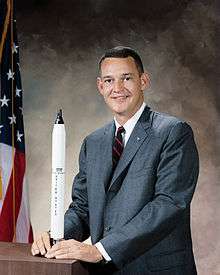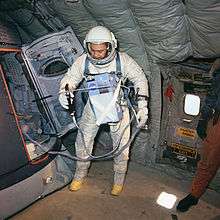Clifton Williams
| Clifton C. Williams Jr. | |
|---|---|
 | |
| NASA Astronaut | |
| Nationality | American |
| Status | Deceased |
| Born |
September 26, 1932 Mobile, Alabama, U.S. |
| Died |
October 5, 1967 (aged 35) near Tallahassee, Florida, U.S. |
Resting place | Arlington Cemetery [1] |
Other names | Clifton Curtis Williams Jr. |
Other occupation | Naval aviator, test pilot |
| Auburn University, B.S. 1954 | |
| Rank | Major, USMC |
| Selection | 1963 NASA Group 3 |
| Missions | None |
Clifton Curtis "C.C." Williams Jr. (September 26, 1932 – October 5, 1967), (Major, USMC), was an American naval aviator, test pilot, mechanical engineer, Major in the United States Marine Corps, and NASA astronaut, who was killed in a plane crash; he had never been to space. The crash was caused by a mechanical failure in a NASA T-38 jet trainer, which he was piloting to visit his parents in Mobile, Alabama. The failure caused the flight controls to stop responding, and although he activated the ejection seat, it did not save him. He was the fourth astronaut from NASA's Astronaut Group 3 to have died, the first two (Bassett and Freeman) having been killed in separate T-38 flights and (Chaffee) in the Apollo 1 fire earlier that year.[2] The aircraft crashed in Florida near Tallahassee within an hour of departing Patrick AFB.
Although he was never on a spaceflight, he served as backup pilot for the mission Gemini 10, which took place in July 1966. Following this mission he was selected to be the Lunar Module Pilot for an Apollo mission to the Moon commanded by Pete Conrad. Following Williams' death, Alan Bean became Lunar Module Pilot for Conrad's mission, which ended up being Apollo 12, the second lunar landing.
Biography
Early life and education
Williams was born on September 26, 1932, in Mobile, Alabama, to parents Clifton Curtis Williams Sr. (1909–1968) and Gertrude (née Medicus) Williams (1913–2002).[3][4] He had a younger brother, Richard, born in 1935.[5] Williams was active in the Boy Scouts of America where he achieved its second highest rank, Life Scout.[6] Williams attended Murphy High School in Mobile, from which he graduated in 1949. He received a Bachelor of Science degree in Mechanical Engineering from Auburn University (AU), Auburn, Alabama in 1954. Having joined the Navy ROTC while at AU, he was commissioned a Second Lieutenant in the Marine Corps on August 9, 1954.
His hobbies included hunting, golf, and water sports.
Flight experience
After completing The Basic School at Marine Corps Base Quantico, Virginia, he was sent to NAS Pensacola, Florida, for flight training. He became a Naval Aviator in August 1956, and served with operational tactical jet squadrons of the Fleet Marine Force. He then attended the U.S. Naval Test Pilot School at NAS Patuxent River, Maryland. Following graduation from USNTPS in June 1961, as part of Class 28,[7] he was test pilot for three years in the Carrier Suitability Branch of the Flight Test Division at NAS Patuxent River. His work there included both land-based and shipboard tests of the F-8E, TF-8A, F-8E (attack), and A-4E aircraft and the automatic carrier landing system (ACLS). While at NAS Patuxent River, he was selected for the NASA astronaut program in the third group of prospective Gemini and Apollo astronauts in late 1963.[4]
Of the 2,500 hours flying time accumulated, he has more than 2,100 hours in jet aircraft.[4]

NASA career

| “ | I'd like to go on every flight. Of course, if you said which mission I would most like to have, I'd say the first lunar flight you make from the standpoint of personal satisfaction and accomplishment. | ” |
| — Answering the question which mission he would like to fly.[8] | ||
On October 18, 1963, Major Williams was named by NASA as one of their third group of astronauts, along with thirteen others. This group included Buzz Aldrin, who took part in the first lunar landing in 1969, as well as Roger B. Chaffee, who died in the Apollo 1 fire in 1967.
Williams served as the backup pilot for Gemini 10, which took place in July 1966.[4] Later that year Pete Conrad chose Williams to be the Lunar Module Pilot on the mission for which Conrad was Commander, which would serve as the back-up Apollo 9 crew, and later become Apollo 12.[9] After his death, his position on Conrad's crew was filled by Alan Bean, who had been his Commander on the Gemini 10 backup crew.
Marriage and children
When Williams was named an astronaut, he held the distinction of being the only bachelor in the group.[9] This changed when he married Jane Elizabeth Lansche (known as "Beth"),[2][4] who was a former waterskiing performer at the Cypress Gardens theme park in Florida.[9] Upon the announcement of their engagement, the press feigned disappointment over the loss of the nation's only bachelor astronaut.[2] The couple met in June 1957. They were married on July 1, 1964, in St. Paul's Catholic Church in New Bern, North Carolina, which was Lansche's hometown.[2] The couple had two children. Their first daughter, Catherine Ann, was born on January 6, 1967.[2] Their second daughter, Jane Dee Williams, was born on May 31, 1968, nearly eight months after Williams had died.[2]
Death
Williams died after a mechanical failure caused the aileron controls to jam on his T-38 jet trainer near Tallahassee, Florida on October 5, 1967. His plane went into an uncontrollable aileron roll while he was flying from Cape Canaveral to Mobile, Alabama, en route to see his father who was dying of cancer.[9] The aircraft dived straight down, between pine trees 30 metres (98 ft) apart, and crashed without touching them, although it did singe them from a fire caused by the crash. According to an Air Force spokesman, Clifton's plane disintegrated.[10] The jet was flying at 6,800 metres (22,300 ft) when it performed a sudden roll to the left and dived into the ground, almost straight down, at 1,125 kilometres per hour (699 mph). Williams ejected at 450 metres (1,480 ft) altitude, but the plane was traveling too fast at too low an altitude for the seat to land safely.[9]
Organizations
He was an associate member of the Society of Experimental Test Pilots and member of Pi Tau Sigma (national mechanical honorary), and Tau Beta Pi (national engineering society).
Honors
The Apollo 12 mission patch has four stars on it - one each for the three astronauts who flew the mission, and one for Williams (on Bean's suggestion). Also, his naval aviator wings were placed to rest on the lunar surface in C.C.'s honor. Williams is buried in Arlington National Cemetery.[1] Williams' name appears on NASA's Space Mirror Memorial.
In the 1998 HBO miniseries From the Earth to the Moon, Williams was played by Jim Leavy.
See also
References
- 1 2 "Clifton Curtis Williams Jr., Major, United States Marine Corps, American Astronaut". Arlington National Cemetery. Retrieved 2007-04-25.
- 1 2 3 4 5 6 Colin Burgess; Kate Doolan; Bert Vis (2003). Fallen astronauts: heroes who died reaching for the moon. University of Nebraska Press. p. 272. ISBN 0-8032-6212-4.
- ↑ C.C. Williams' parents
- 1 2 3 4 5 "Astronaut Bio: Clifton C. Williams Jr.". NASA. October 1967.
- ↑ C.C. Williams' family
- ↑ Clifton C. Williams Jr. at scouting.org Archived March 4, 2016, at the Wayback Machine.
- ↑ C.C. Williams' marine service
- ↑ Clifton C. Williams Jr. quotation
- 1 2 3 4 5 Chaikin, Andrew (1994). A Man on the Moon. Penguin. p. 670.
- ↑ "Williams Wanted To Be First On The Moon", St. Petersburg, FL - Evening Independent newspaper, Oct. 6, 1967
Bibliography
- Codex Regius (2014). The Forgotten Astronauts:A rarely told Chapter of American Spaceflight History. ISBN 1-4996-1012-2.
External links
| Wikimedia Commons has media related to Clifton Williams. |
- Williams at Spaceacts
- C.C. Williams at Astronauts Memorial page
- Astronautix biography of C.C. Williams
